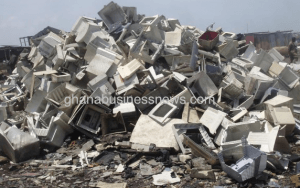New report suggests Hong Kong takes over from Ghana as new global e-waste dumping ground
A new report by the Basel Action Network (BAN) published last year says Hong Kong is becoming the new dumping ground for electronics waste (e-waste) from the US.
The report titled ‘Scam recycling: e-Dumping on Asia by US recyclers’ says up to 20 per cent of all US e-waste is likely being dumped in Hong Kong.
Not long ago, Ghana was described as the world’s e-waste dumping ground, and the Agbogbloshie grounds in Accra, where e-waste was being crudely recycled was labeled the world’s most polluted area.
As recently as June 2016, Ghana was cited as one of the top destinations for the trafficking of illegal hazardous wastes in West Africa in a rapid response assessment of the UN Environmental Programme and INTERPOL.
In the same month, that same year, Ghana passed the E-waste law to deal with the matter.
But the BAN study made reference to an earlier study, e-Trash Transparency Project which found that the illegal exports of e-waste to developing countries has reached alarming proportions.
According to BAN it chose three waste types in this study — LCD monitors with mercury backlights, CRT monitors, and printers, and installed trackers on these items, that are considered hazardous waste under international law.
“To date, the study has witnessed 34 per cent of the 205 tracker deployments move offshore, with 31 per cent of the total going to developing countries. Looking at those that were exported only, 93 per cent of the exports went to developing countries. 87 per cent have gone to Asia, 3 per cent to Africa, 1 per cent to the Middle East, 1 per cent to Latin America and Caribbean region. 7 per cent moved to the developed countries of Mexico and Canada,” it said.
The study also found that of the 152 trackers delivered directly to recyclers, which is the primary subject of the study, 40 per cent were exported — significantly higher than the 15 per cent export rate for the 53 trackers delivered to charities or retailers.
“In the course of the entire pathways (chains) of the 205 tracker movements, the trackers passed through the hands of 168 different identifiable US recyclers. Of these companies delivered to or revealed, over 45 per cent were part of a movement that went offshore (export chain),” the study pointed out.
It further noted that LCDs were exported at the highest rate of the three types of equipment deployed: 53 per cent of LCDs studied were exported, 30 per cent of printers, and 18 per cent of CRTs. LCDs containing mercury lamps, as exclusively deployed in this study, are likely the most toxic of the three.
The study discovered that while there are strict rules on the exportation and importation of e-waste from the US, most of the companies involved flouted the law.
BAN found that many of the countries that were importing the e-waste are among 150 countries prohibited from importing Basel listed hazardous wastes from the US.
“Once the waste has been exported from the US, it is considered “illegal traffic” and is a criminal act for those in Basel Parties to import it,” it indicated.
BAN referred to one rule in the US that requires companies to pre-notify the US Environmental Protection Authority (EPA) if they wish to export some CRTs (CRT Rule).
“However, none of the companies found in this study to be involved in a chain of export for CRTs are listed on the EPA website as having provided the necessary notification; this means those CRT shipments are likely to violate US law,” it said.
According to BAN, it discovered during the study that, by far, most of the exportation went to Hong Kong’s New Territories area with a distant second destination being mainland China.
“These new findings, based on tracking data, have revealed a much different picture than our findings over the past decade where it was observed that the vast majority of e-waste from North America went to mainland China, and most of that to Guiyu, a township and region in Guangdong Province,” it said, adding that, this previous data was the subject of an earlier report it published in 2002.
BAN as a result of the latest findings of its study acknowledged a dramatic geographic shift, which it says is indicative of China’s recently escalated effort to enforce their long-standing e-waste import ban.
But then, ironically, it appears that the Hong Kong (SAR), usually thought of as one of the most technologically and economically advanced areas of China, has not enforced the Chinese import ban as diligently as mainland China has and appears to have in fact become a new pollution haven, the report said.
“Hong Kong’s New Terrritories region near the mainland border now appears to be a new “ground zero” for e-waste processing,” the study concluded.
By Emmanuel K. Dogbevi

